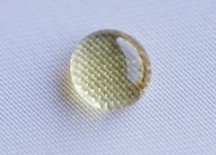Home > Press > Safety of nano-products for human beings and the environment: TechnoTox - a project for the risk assessment of nano materials
 |
| Nano-functionalised textiles repel water and dirt. © Hohenstein Institute |
Abstract:
Nano-particles (Greek: nanos = dwarf) are now being used to create fascinating products with totally new functionalities. These include textiles from which dirt simply runs off or which have an anti-bacterial effect. But as is the case with every new technology, this one must also be safe to use. It is therefore of interest to both manufacturers and users of such high-tech products that nano-particles are harmless for both human beings and the environment over the entire life cycle of the products.
Safety of nano-products for human beings and the environment: TechnoTox - a project for the risk assessment of nano materials
Bönnigheim, Germany | Posted on June 2nd, 2012To this end in December 2010 the "TechnoTox" research project was launched with the objective of performing a situation-based risk assessment of textile nano-products. The project is sponsored by the German state of Baden-Württemberg and is based on an initiative of AFBW e.V. (Allianz Faserbasierte Werkstoffe Baden-Württemberg) and is studying in detail the questions surrounding textile nano-technology
The German Council on the Environment (SRU) published the following statement in 2011 on the use of nano-materials: "To date there has been no scientific proof to the effect that nano-materials, as manufactured and used today, lead to damage to the environment and to health."
However, since an increasing use of nano-functionalised textiles is expected in the future in addition to possible uses of new nano-materials which have not yet been considered in previous risk assessments, there is still a need for meaningful test methods on the effects of nano-materials and their toxicological properties.
The "TechnoTox" project is studying whether nano-functionalised textiles are safe for human beings and the environment. Data on behaviour, retention and on the biological effect of nano-functionalised fibre-based materials in relation to environmental conditions is being prepared and a situation-based risk assessment is being carried out. During the project methods are also being developed which have made possible the proof and characterisation of nano-particles alongside the analysis of their human and eco-toxicological risk potential in relevant environmental media.
The project is being run in close cooperation between science and industry. The project partners involved are the Institut für Textil- und Verfahrenstechnik Denkendorf (ITV), the Hohenstein Institute for Textile Innovation and several industrial companies.
Through their participation in the project all participants want to drive forward their own developments in nano-technologically modified textiles and ensure their safety from a risk perspective based on the accompanying and complementary test methodology.
An interdisciplinary approach is secured through the involvement of commercial companies. This is being implemented using the example of the textile chain of companies in Baden-Württemberg.
The objective of this project is to expand the competitiveness of the innovative companies which are producing nano-products plus also to process nano-materials or nano-technologically functionalised materials as well as to support the responsible utilisation of nano-technology.
The project is using a complementary solutions-based approach in which physical materials studies on exposure are directly coupled to effect-related biological studies. The results of the studies are aggregated and assessed for any correspondence of effects (of the effective concentration for example).
The determination of particle properties and effects on real products enables a comprehensive hazard and risk assessment to be made for nano-technology functionalised fibre-based materials in consumer products.
####
For more information, please click here
Contacts:
Ingrid Deilei.de
Schloss Hohenstein
Bönnigheim, Germany, 74357
07143 271 724
07143 271 721
Copyright © AlphaGalileo
If you have a comment, please Contact us.Issuers of news releases, not 7th Wave, Inc. or Nanotechnology Now, are solely responsible for the accuracy of the content.
| Related News Press |
News and information
![]() Researchers develop molecular qubits that communicate at telecom frequencies October 3rd, 2025
Researchers develop molecular qubits that communicate at telecom frequencies October 3rd, 2025
![]() Next-generation quantum communication October 3rd, 2025
Next-generation quantum communication October 3rd, 2025
![]() "Nanoreactor" cage uses visible light for catalytic and ultra-selective cross-cycloadditions October 3rd, 2025
"Nanoreactor" cage uses visible light for catalytic and ultra-selective cross-cycloadditions October 3rd, 2025
Announcements
![]() Rice membrane extracts lithium from brines with greater speed, less waste October 3rd, 2025
Rice membrane extracts lithium from brines with greater speed, less waste October 3rd, 2025
![]() Researchers develop molecular qubits that communicate at telecom frequencies October 3rd, 2025
Researchers develop molecular qubits that communicate at telecom frequencies October 3rd, 2025
![]() Next-generation quantum communication October 3rd, 2025
Next-generation quantum communication October 3rd, 2025
![]() "Nanoreactor" cage uses visible light for catalytic and ultra-selective cross-cycloadditions October 3rd, 2025
"Nanoreactor" cage uses visible light for catalytic and ultra-selective cross-cycloadditions October 3rd, 2025
Textiles/Clothing
![]() Protective equipment with graphene nanotubes meets the strictest ESD safety standards March 25th, 2022
Protective equipment with graphene nanotubes meets the strictest ESD safety standards March 25th, 2022
![]() Polymer fibers with graphene nanotubes make it possible to heat hard-to-reach, complex-shaped items February 11th, 2022
Polymer fibers with graphene nanotubes make it possible to heat hard-to-reach, complex-shaped items February 11th, 2022
![]() Flexible material shows potential for use in fabrics to heat, cool July 3rd, 2020
Flexible material shows potential for use in fabrics to heat, cool July 3rd, 2020
Safety-Nanoparticles/Risk management
![]() Onion-like nanoparticles found in aircraft exhaust May 14th, 2025
Onion-like nanoparticles found in aircraft exhaust May 14th, 2025
![]() Closing the gaps — MXene-coating filters can enhance performance and reusability February 28th, 2025
Closing the gaps — MXene-coating filters can enhance performance and reusability February 28th, 2025
|
|
||
|
|
||
| The latest news from around the world, FREE | ||
|
|
||
|
|
||
| Premium Products | ||
|
|
||
|
Only the news you want to read!
Learn More |
||
|
|
||
|
Full-service, expert consulting
Learn More |
||
|
|
||








